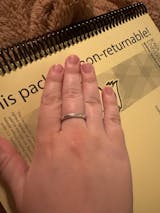Garden Quartz: Navigating the Stitch-Glued Secrets of the Mineral Market
投稿者 :Ali Tesh on
Overview:
Chemical formula: SiO2; Silicate
Hardness: 7
Rarity: Common; can be expensive for very high quality specimens or additional inclusions with other minerals such as rutile, epidote and tourmaline
Colors: Green, red, brown, pink, purple, black, grey
Coloring comes from various inclusions such as: Chlorite, Hematite, Magnetite, Feldspar and can contain other trace amounts of minerals.
Garden Quartz can be found in other Quartz varieties like Smoky, Clear, Citrine etc.
Trade names:
Lodolite, Garden Quartz, Shaman Quartz, Chlorite Quartz, Dream Stone, Phantom Quartz
Locations: Mainly Brazil and Madagascar but can be found wherever Quartz is found.
What are Stitch Glued Specimens?

Stitch gluing is the act of attaching separate pieces of minerals together with resin or industrial adhesive. They can attach slabs of various materials together, cut and carve them into whatever shape they want. This is done commonly in towers or pendulums (typically are meant to represent the different chakras) example pictured below:

Picture courtesy of Earthbound Trading Co
Here's a few tips on how to tell if your Garden Quartz is stitch-glued:
All pictures below are enhanced Garden Quartz and not 100% natural:




Notice something in common with all of these spheres? The dramatic contrast of “chlorite” on the outside of the sphere is not natural. Conveniently it will usually be half or close to half of the entire structure of the specimen.
Examples of Lab Grown Chlorite Cabochons:
These can sometimes be trickier to decipher because some of the coloring used can have naturally occuring hues.
Below are pictures of grown & dyed Garden Quartz:

 Pictures above courtesy of Mindat.org discussion forum "Garden Quartz aka Phantom Quartz/Lodolite: fake?" from user Karen VC
Pictures above courtesy of Mindat.org discussion forum "Garden Quartz aka Phantom Quartz/Lodolite: fake?" from user Karen VC

Most have a telltale sign on the backs. Solid patches, like the one pictured below, on the back are usually not natural. However, because cabochons are generally much smaller in size compared to spheres and towers, it can be hard to distinguish what was cut from a larger natural chunk with a chlorite patch and what is lab grown.

Below are Examples of Natural Garden Quartz
Pictures by Gemstonepoint on Etsy

Towers are less commonplace for this type of stitch gluing to occur. Take note again of the patchy pattern, this is an example of what an outer layer of what natural chlorite patches looks like

Nice blending and variation on the edges where the Quartz and Chlorite meet. There's no harsh lines or unnatural coloring

Most natural Chlorite inclusions are subtle and not as intense as the previously shown altered spheres (above is natural)
Garden Quartz Patterns
Below are examples of how chlorite can form in unique patterns. This is one way to avoid fakes because these patterns are hard to replicate, for now.

Picture from Jibrilgems on Etsy
This type of pattern is where Garden Quartz gets the 'Phantom Quartz' trade name. This shading of chlorite creates a ghost-like, wispy, phantom look. Usually this pattern starts off dense and tapers out to the rest of the specimen but sometimes these can occur by themselves in subtle standalone streaks.

Picture property of MOSAIC Lille

Picture property of crystal_lab1011 on Ebay
This type of pattern is also marketed as 1000 Layer Quartz. It's extremely hard to replicate and notice how although they are heavily chlorite included they dont have solid pacthes on the outside.
Popular Inclusions:
This practice can be seen with other minerals such as Pyrite and Rutile.
Pyrite:

Rutile

Picture property of crystalwholesaleusa.com
Picture above is natural. I believe most rutilated stitch-glued Garden Quartz do contain natural rutilated quartz but the chlorite is not natural. That’s not to say rutile can’t be faked-that’s a whole other blog post
Garden Quartz, Malachite & Azurite:


Below are examples of natural Malachite and Azurite geodes. This would be a more typical formation and any Chlorite included would be in patches/small splotches












